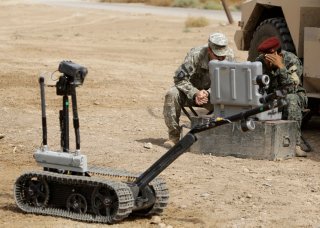Textron's Ripsaw Robotic Combat Vehicle Is Changing Unmanned Warfare
The American Textron isn’t the only company charging forward in developing unmanned, all-electric systems.
Here’s What You Need to Remember: The Ripsaw M5 is an unmanned, multi-mission Robotic Combat Vehicle (RCV).
Textron Systems is the aerospace and defense manufacturing firm responsible for developing a wide range of vehicles and weapon systems including the U.S. Navy’s Landing Craft Air Cushions. The company is also a contender for the Army’s Next Generation Squad Weapon competition and has been developing yet another interesting platform.
Their Ripsaw M5 is an unmanned, multi-mission Robotic Combat Vehicle (RCV) that has gone through several prototypes and is currently in its fifth-generation. Textron currently manufactures the Ripsaw in two variants, a 7.5 ton light variant, as well as a larger 10.5 medium variant. Both the light and medium variants can be equipped with conventional diesel engines, or with a hybrid electric drivetrain.
Textron touts the Ripsaw as a multi-mission, multi-domain platform, capable of performing a variety of missions, including breaching/mine clearing, reconnaissance and surveillance, as well as direct-action missions. To those ends, it can be equipped with a heavy machine gun remote weapon station, a turret for a medium caliber cannon, or anti-aircraft missiles. Armor, suspension, and drivetrain are modular, and can be customized to mission requirements.
Textron is working in tandem with the U.S. Army’s Combat Capabilities Development Command Armaments Center, a research and development command that calls itself the Army’s “scientific and technological foundation” that conducts “world-leading research, development, engineering and analysis.”
Though the Army has been tinkering with the Ripsaw for over a decade, Textron is slated to deliver a new, all-electric variant called the Ripsaw M5-E sometime in 2021, Jane’s reported. The M5-E test platform will ship as a flat-top, lacking a remote weapon station or turret in order to allow the Army to test integrating different weapon systems.
All-electric vehicles have typically struggled to match the ranges of combustion engines, and recharge times are slower than a tank refill—both of which Textron would have to address to make the M5-E a serious competitor to its diesel and hybrid counterparts.
All-Electric, All the Time
The American Textron isn’t the only company charging forward in developing unmanned, all-electric systems. South Korea’s Hyundai Rotem, builder of a number of the Republic of Korea’s land combat systems, including their K1 and K2 main battle tanks, also has something similar to Textron’s Ripsaw in the works.
Their Multipurpose Unmanned Ground Vehicle is also an all-electric design, albeit much smaller at up to 2 tons when fully equipped. According to Jane’s the MUGV’s mission profile will probably be smaller than that of the Ripsaw, supporting ground troops via casualty evacuation and ammunition resupply, though Hyundai artwork show’s the MUGV equipped with what appears to be a medium machine gun. Interestingly, the MUGV’s battery is said to be water-cooled, and sports punctureless, airless tires.
Postscript
Change is coming for ground troops, and if the technical hurdles inherent to all-electric vehicle technology—namely range and recharge times—can be overcome, robot combat vehicles could become the silent killers of the future.
Caleb Larson is a Defense Writer with The National Interest. He holds a Master of Public Policy and covers U.S. and Russian security, European defense issues, and German politics and culture.
This article first appeared in December 2020 and is being reprinted due to reader interest.
Image: Reuters

